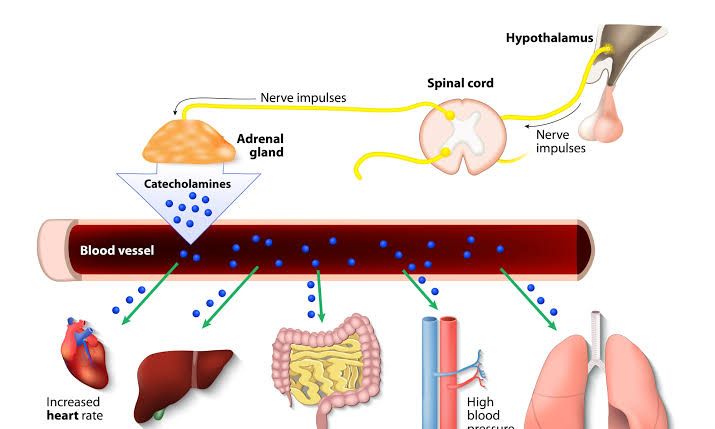
The adrenal medulla secretes two primary catecholamines: adrenaline (also known as epinephrine) and noradrenaline (also known as norepinephrine). These hormones are part of the body’s response to stress and are released into the bloodstream during situations that activate the “fight-or-flight” response.
Actions of Catecholamines in the Human Body
Catecholamines, specifically adrenaline and noradrenaline, have a wide range of effects on various organ systems in the human body. Their actions include:
- Cardiovascular System:
- Increased Heart Rate: Both adrenaline and noradrenaline stimulate beta-adrenergic receptors in the heart, leading to an increase in heart rate (tachycardia).
- Increased Blood Pressure: They cause vasoconstriction (narrowing of blood vessels), which raises blood pressure.
- Redistribution of Blood Flow: Blood is redirected to vital organs like the brain and muscles while reducing flow to less critical areas such as the gastrointestinal tract.
- Respiratory System:
- Bronchodilation: Adrenaline relaxes smooth muscle in the airways, leading to widened bronchioles, which improves oxygen intake.
- Metabolic Effects:
- Glycogenolysis: Adrenaline stimulates glycogen breakdown in the liver and muscles, increasing glucose availability for energy.
- Lipolysis: It promotes fat breakdown in adipose tissue, releasing free fatty acids for energy use.
- Inhibition of Insulin Secretion: This ensures that glucose remains available for immediate use by muscles rather than being stored.
- Central Nervous System:
- Catecholamines enhance alertness, focus, and readiness to respond to stressors.
- Pupil Dilation:
- Adrenaline causes dilation of pupils (mydriasis), improving vision during stressful situations.
- Sweat Glands Activation:
- Increased sweating helps regulate body temperature during physical exertion or stress.
- Suppression of Non-Essential Functions:
- Functions such as digestion are temporarily suppressed to prioritize energy for survival-related activities.
Factors That Regulate Adrenal Medullary Secretion
The secretion of catecholamines from the adrenal medulla is regulated by several factors:
- Sympathetic Nervous System Activation:
- The adrenal medulla is directly controlled by preganglionic neurons of the sympathetic nervous system. Stressful stimuli such as fear, exercise, or low blood sugar activate these neurons, triggering catecholamine release.
- Stress Response (“Fight-or-Flight”):
- Physical or emotional stress activates the hypothalamus-pituitary-adrenal axis and sympathetic nervous system, leading to increased secretion of adrenaline and noradrenaline.
- Hypoglycemia (Low Blood Sugar):
- Low blood glucose levels stimulate adrenaline release to promote glycogenolysis and gluconeogenesis for restoring normal glucose levels.
- Exercise:
- Physical activity increases catecholamine secretion due to heightened metabolic demands on muscles and other tissues.
- Hypoxia (Low Oxygen Levels):
- Reduced oxygen availability can trigger catecholamine release to enhance oxygen delivery through increased cardiac output and redistribution of blood flow.
- Temperature Changes:
- Exposure to cold can stimulate noradrenaline release as part of thermoregulation mechanisms.
- Drugs or Pharmacological Agents:
- Certain medications or substances like nicotine can stimulate catecholamine release by activating nicotinic acetylcholine receptors on chromaffin cells within the adrenal medulla.
- Chronic Hypoxia Adaptation (in High Altitude Natives):
- In populations adapted to high altitudes, chronic hypoxia leads to altered regulation with reduced catecholamine secretion compared to low-altitude populations.







